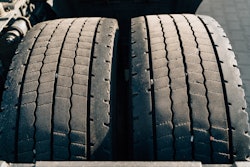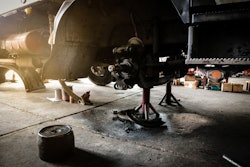Note: This is the third in a series that looks at the diesel particulate filter and maintenance best practices that an impact its lifecycle. The first installment, "Diesel coolant heaters boost DPF performance, reduce engine wear" can be found here. The second, Biodiesel, renewable diesel show DPF and engine performance improvements, can be found here.
The diesel particulate filter (DPF) has served as gatekeeper between a fleet tractor and its emissions compliance for nearly 15 years, but even today few things draw more ire from drivers and maintenance managers than a truck's aftertreatment system.The DPF collects upwards of 98% of particulate matter emissions in the form of ash, which is comprised of metallic compounds that originate in the engine oil, fuel, wear metals from the engine, or from dirt in the air the engine consumes. Upwards of 90% of the ash that goes into the DPF is from the lubricant.
Ash and soot buildup – left behind when engine oil is burned during combustion – shrinks the size of the DPF, and causes engine back pressure and excessive regeneration cycles.
“Controlling oil consumption is a principal way to maximize DPF servicing intervals,” said Shell Global Solutions OEM Technical Manager Karin Haumann. “Oil being consumed (i.e. burned) leaves behind an ash residue that comes from the non-combustible, inorganic material that is carried through the exhaust.”
Most ash is produced by phosphorus, zinc, boron and moly additives, and modern engine oils – namely API CJ-4, CK-4 and FA-4 formulations – are regulated to a fewer than 1% ash.
“We see these fleets that are in on-highway operation that are 750,000 miles – even a million miles – before they even touch their DPF systems because there staying up to temperature, because oil consumption is under control [and] because they're using a quality fuel." Mobil Commercial Lubricants Applications Engineer Paul Cigala
“API categories prior to these, such as API CI-4 PLUS, CI-4 and CH-4, do not restrict ash," said Kevin Carabell, Technical Team Leader at Chevron Lubricants. "As a result, oils meeting these older specifications will have up to two-times more ash than oils meeting the recent specifications. In choosing an oil that would be less prone to producing DPF-clogging ash, look for API CK-4, FA-4 or CJ-4."
Metals are used in engine oils in the form of detergents, anti-wear agents or other multi-functional additives. When they're consumed in the combustion chamber, "that's where you're getting your ash content in your exhaust stream," said Mobil Commercial Lubricants Applications Engineer Paul Cigala.
One way to solve the problem of ash clogging in DPFs would be to formulate an oil without ash-forming additives, but Haumann noted these inorganic additives do useful things and are proven to provide engine protection.
“The compromise is to use inorganic material, but limiting the amount,” Haumann said.
A truck's duty cycle – like stop-and-go driving or high idle applications – and fuel quality also play a role in oil consumption, but the EPA requires that DPF service related to ash accumulation must not occur sooner than 150,000 miles for heavy duty trucks. The service interval for most OEMs is now well above 400,000 miles – and for some, upwards of 800,000 miles.
“We see these fleets that are in on-highway operation that are 750,000 miles – even a million miles – before they even touch their DPF systems because they're staying up to temperature,” Cigala said, “because oil consumption is under control [and] because they're using a quality fuel."
While synthetic base oils can allow lower viscosity engine oils to be formulated to minimize oil consumption, Haumann said “key contributors to oil consumption are piston and ring deposits and wear. A clean engine with clean pistons will prevent oil from passing by the rings and entering the combustion chamber and being consumed. Excessive ring and/or cylinder wear can also lead to excessive oil consumption which can lead to shorter DPF cleaning intervals.”
An ideal oil consumption range can depend on engine OEM and vehicle application, but Cigala said a good rule of thumb is, "if I'm seeing anything more than two to three quarts in a 10,000 to 15,000 mile range, I might want to start looking and try and get an understanding of what's happening."
Beyond consumption, Cigala said fleets should ensure that engine oil stays within its intended grade, is not being thinned or diluted, and that it is being changed at OEM recommended intervals. Used oil analysis, he added, plays a role in obtaining an understanding of the condition of the engine oil's oxidization level, a drop in viscosity, fuel dilution or potential contamination.
“If you get excessive fuel dilution in there, you drop the viscosity,” Cigala said. Not only will that cause excess wear inside the engine, but Cigala said that "oil now will start going past the rings, will end up in the combustion chamber and eventually in the aftertreatment system.”












